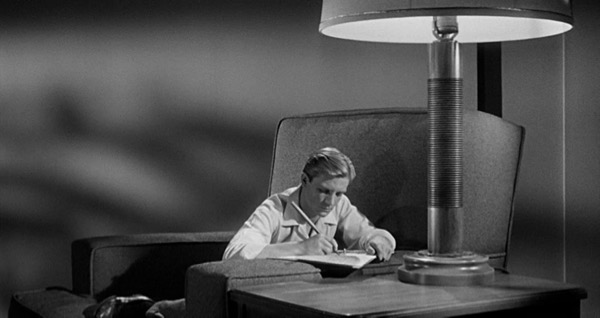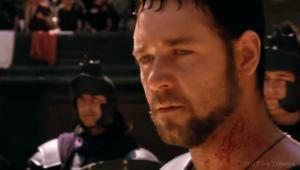This is definitely one of the best sci-fi films produced in the 1950s. Even though I've added it to my Christmas list, I'm still disappointed that Criterion hasn't entered the UHD bluray market. War of the Worlds was another '50s sci-fi classic they restored in 4K but released in 1080P. If I had to pick one sci-fi-film from this decade to receive a UHD release it would have to be Forbidden Planet (Warner Brs. released the BD and they did a fantastic job with 2001, so maybe there's a chance). I'm hoping that if the 4K Universal Classic Monsters set sells well, Criterion will rethink its position on UHD and release these films in 4K. I'll keep my fingers crossed until then.
Let's Get Small: The Incredible Shrinking Man

But when you weren't busy designing that air-raid shelter, and schools weren't holding duck-and-cover drills, Americans still went to the movies. And among Baby Boomers science-fiction and horror films became immensely popular — arguably the Marvels of their day. An Internet search revealed 40 such films released in 1956 alone.
Most '50s films in this category were low-budget schlock, often playing in the then-popular drive-in theaters and/or as the bottom-feeders in the double features of the time. Yes, Virginia, you got two films for the price of one ticket, but didn't expect to see Lawrence of Arabia and West Side Story on the same program. More likely you'd see The Man from Planet X and Attack of the 50-Foot Woman. Talk about your female empowerment — eat your heart out Wonder Woman!
But some of those films turned out to be enduring classics, including War of the Worlds, 20,000 Leagues Under the Sea, The Day the Earth Stood Still, Forbidden Planet, When Worlds Collide, and Godzilla — the latter racking up the longest-lived and most impressive resume of them all.
But possibly the most unsung '50s sci-fi classic is 1957's The Incredible Shrinking Man. Based on a novel by Richard Matheson, a prolific book author and screenwriter, it was one of the most profitable sci-fi films of its release year, though hardly a blockbuster in the same sense as today's Marvel/James Bond/Star Wars franchises.
The Incredible Shrinking Man is the story of Scott Carey, accidentally exposed to some sort of radioactive cloud (cue the Cold War paranoia referenced earlier). Its effects, possibly enhanced by later exposure to garden weed killer (double paranoia!), are initially unnoticeable. But a few months later he finds that his clothes don't quite fit and he's now a bit shorter than his wife. Soon the problem becomes too obvious to ignore. Before long Scott's living in a dollhouse, gets chased by the family cat, falls into the basement, and makes an empty matchbox his refuge. Soon he's forced to defend himself from a terrifying enemy. As Scott confronts these new challenges the film turns frighteningly real (though the film is unlikely to truly disturb anyone over the age of eight).
The film's special effects are state-of-the-art — for 1957. Forty years before the availability of effective CGI, filmmakers had to rely on in-camera practical effects. Fortunately, even 1950's Hollywood had extensive experience with such techniques. Enlarged sets make Scott's several stages of shrinkage totally believable. The proportions don't always look spot on, and the matte work occasionally gives the trickery away, but it never detracts from the film's believability.
The Incredible Shrinking Man inevitably inspired (much later) knock-offs, including The Incredible Shrinking Woman (1981) and Honey I Shrunk the Kids (1989 plus later sequels). But these copycats were all comedies. The Incredible Shrinking Man is serious science fiction.
The film was recently re-released by The Criterion Collection (it's been on home video before). The black and white images are consistently crisp and free of wear; I doubt it looked any better on its original theatrical release. The 4K restoration work was performed on the original film elements, though the release here is 2K. A 4K/HDR version would have been welcomed, but there's nothing to complain about in the disc's video quality. It's free of unwanted noise and crisply detailed, apart from a few scenes showing a barely noticeable softness due to the effects work. The lossless mono soundtrack is also clean and always intelligible. There's no mistaking it for the best in 2021 film audio, but it's never distracting.
The extensive extra features are characteristic of The Criterion Collection. The main attraction is a commentary track (a vanishing breed on disc releases these days) by genre film historian Tom Weaver and horror-music expert David Schecter. There's also a discussion by special effects experts Craig Barron (video) and Ben Burtt (sound), and much, much, more. These extras alone run for over three hours — not counting the commentary track!

Spoiler Alert!
This part of the discussion covers a few additional scenes, plus some logic plot holes that I didn't note the first time I watched the film. If you haven't yet seen it you might want to avoid reading this section until you do — though I suspect you'll read it now regardless!
The most disturbing scenes in the film involve animals we normal don't fear (though spiders of any size are creepy). But at Scott's size they'd be as terror-inducing as a giant, uncaged, hungry tiger would be to us.
Scott's housecat is a key character in driving the film into its final act. She's accidentally let into the house (why his wife was so careless with such an obvious threat remains a puzzle). Scott's near escape from the cat forces him into the basement where he can't be seen or heard by his wife or brother. He can't climb the basement stairs, and his tiny voice can't carry very far. It's strongly implied (but not spoken) that his wife and brother assume that the cat killed Scott and ate him. But that possibility could have been easily checked by X-raying the cat and/or inspecting its....you know what.
Once Scott gets trapped in the basement the film really takes off. The search for food (particularly in a loaded mouse trap), a near flood when a water heater fractures and fills the basement to a life-threatening (for Scott) depth and, most compelling of all, a battle with a hungry spider with Scott's only weapons, a pair of scissors and an old pin that he sharpens into a spear, all move the action toward its eventual conclusion.
The spider used was real. The production went through several tarantulas (the heat from the set lights kept killing them off). According to the commentary track, tarantulas weren't the first choice as they don't spin webs. The filmmakers originally wanted to use a black widow, but they were too small to photograph effectively.
Some of the test-screening audiences of the time wanted Scott's shrinking to finally reverse. But wouldn't that make for a longer and/or tacked-on ending? I won't spoil the film's actual conclusion here, but the final scenes are both bittersweet and uplifting.
Blu-ray, The Criterion Collection
Studio: Universal Pictures, 1957
Format: 1080p video, LPCM 1.0 audio, Region A
Length: 81 minutes
Director: Jack Arnold
Starring Grant Williams, April Kent, Randy Stuart
- Log in or register to post comments































































